什么是多線程編程?
1、線程和進程的區別
進程是指正在運行的程序,它擁有獨立的內存空間和系統資源,不同進程之間的數據不共享。
線程是進程內的執行單元,它與同一進程內的其他線程共享進程的內存空間和系統資源。
2、多線程的優勢和應用場景
多線程是一種并發編程方式,它的優勢包括:
提高程序的響應速度和運行效率(多核CPU下的多線程)
充分利用CPU資源,提高系統的利用率
支持多個任務并行執行,提高程序的可擴展性和可維護性
Linux下的多線程編程
Linux下C語言多線程編程依賴于pthread多線程庫。pthread庫是Linux的多線程庫,是POSIX標準線程API的實現,它提供了一種創建和操縱線程的方法,以及一些同步機制,如互斥鎖、條件變量等。
頭文件:
#include
編譯鏈接需要鏈接鏈接庫 pthread。
一、線程的基本操作
1、pthread_create
/** *@brief創建一個線程 * *Detailedfunctiondescription * *@param[in] thread:一個指向線程標識符的指針,線程調用后,該值被設置為線程ID;pthread_t為unsigned long int *@param[in]attr:用來設置線程屬性 *@param[in]start_routine:線程函數體,線程創建成功后,thread指向的內存單元從該地址開始運行 *@param[in]arg:傳遞給線程函數體的參數 * *@return線程創建成功,則返回0,失敗則返回錯誤碼,并且thread內容是未定義的 */ intpthread_create(pthread_t*thread,constpthread_attr_t*attr,void*(*start_routine)(void*),void*arg);
例子test.c:創建一個線程,每1s打印一次。
#include #include #include #include staticpthread_ts_thread_id; staticunsignedchars_thread_running=0; void*thread_fun(void*arg) { s_thread_running=1; while(s_thread_running) { printf("threadrun... "); sleep(1); } pthread_exit(NULL); } intmain(void) { intret=0; printf("BeforeThread "); ret=pthread_create(&s_thread_id,NULL,thread_fun,NULL); if(ret!=0) { printf("thread_createerror! "); exit(EXIT_FAILURE); } ret=pthread_join(s_thread_id,NULL);///
編譯、運行:
gcctest.c-otest-lpthread
2、pthread_join
/** *@brief等待某個線程結束 * *Detailedfunctiondescription:這是一個線程阻塞函數,調用該函數則等到線程結束才繼續運行 * *@param[in]thread:某個線程的ID *@param[in]retval:用于獲取線程start_routine的返回值 * *@return線程創建成功,則返回0,失敗則返回錯誤碼,并且thread內容是未定義的 */ intpthread_join(pthread_tthread,void**retval);
例子test.c:創建一個線程,進行一次加法運算就返回。
#include #include #include #include staticpthread_ts_thread_id; staticunsignedchars_thread_running=0; void*thread_fun(void*arg) { staticintres=0; inta=1,b=2; res=a+b; sleep(1); printf("threadrun,a+b=%d,addr=%p ",res,&res); pthread_exit(&res); } intmain(void) { intret=0; int*retval=NULL; printf("BeforeThread "); ret=pthread_create(&s_thread_id,NULL,thread_fun,NULL); if(ret!=0) { printf("pthread_createerror! "); exit(EXIT_FAILURE); } ret=pthread_join(s_thread_id,(void**)&retval);///
編譯、運行:
3、pthread_exit
/** *@brief退出線程 * *Detailedfunctiondescription * *@param[in]retval:它指向的數據將作為線程退出時的返回值 * *@returnvoid */ voidpthread_exit(void*retval);
線程將指定函數體中的代碼執行完后自行結束;
線程執行過程中,被同一進程中的其它線程(包括主線程)強制終止;
線程執行過程中,遇到 pthread_exit() 函數結束執行。
例子test.c:創建一個線程,每個1s打印一次,打印超過5次時調用pthread_exit退出。
#include #include #include #include staticpthread_ts_thread_id; staticunsignedchars_thread_running=0; conststaticchar*thread_exit_str="thread_exitok!"; void*thread_fun(void*arg) { staticintcnt=0; s_thread_running=1; while(s_thread_running) { cnt++; if(cnt>5) { pthread_exit((void*)thread_exit_str); } printf("threadrun... "); sleep(1); } pthread_exit(NULL); } intmain(void) { intret=0; void*thread_res=NULL; printf("BeforeThread "); ret=pthread_create(&s_thread_id,NULL,thread_fun,NULL); if(ret!=0) { printf("thread_createerror! "); exit(EXIT_FAILURE); } ret=pthread_join(s_thread_id,(void**)&thread_res); if(ret!=0) { printf("thread_joinerror! "); exit(EXIT_FAILURE); } printf("AfterThread,thread_res=%s ",(char*)thread_res); exit(EXIT_SUCCESS); }
編譯、運行:
使用return退出線程與使用pthread_exit退出線程的區別?
return為通用的函數退出操作,pthread_exit專用與線程,既然pthread庫有提供專門的函數,自然用pthread_exit會好些,雖然使用return也可以。
看看return退出線程與使用pthread_exit退出線程的具體區別:退出主線程。使用pthread_exit退出主線程只會終止當前線程,不會影響進程中其它線程的執行;使用return退出主線程,主線程退出執行很快,所有線程都會退出。
例子:使用pthread_exit退出主線程
#include #include #include #include staticpthread_ts_thread_id; staticunsignedchars_thread_running=0; conststaticchar*thread_exit_str="thread_exitok!"; void*thread_fun(void*arg) { sleep(1); printf("thread_funrun... "); pthread_exit(NULL); } intmain(void) { intret=0; void*thread_res=NULL; printf("BeforeThread "); ret=pthread_create(&s_thread_id,NULL,thread_fun,NULL); if(ret!=0) { printf("thread_createerror! "); exit(EXIT_FAILURE); } printf("mainthreadexit "); pthread_exit(NULL); }
編譯、運行:
例子:使用return退出主線程
#include #include #include #include staticpthread_ts_thread_id; staticunsignedchars_thread_running=0; conststaticchar*thread_exit_str="thread_exitok!"; void*thread_fun(void*arg) { sleep(1); printf("thread_funrun... "); pthread_exit(NULL); } intmain(void) { intret=0; void*thread_res=NULL; printf("BeforeThread "); ret=pthread_create(&s_thread_id,NULL,thread_fun,NULL); if(ret!=0) { printf("thread_createerror! "); exit(EXIT_FAILURE); } printf("mainthreadexit "); return0; }
編譯、運行:
4、pthread_self
/** *@brief用來獲取當前線程ID * *Detailedfunctiondescription * *@param[in]void * *@return返回線程id */ pthread_tpthread_self(void);
例子:
#include #include #include #include staticpthread_ts_thread_id; staticunsignedchars_thread_running=0; conststaticchar*thread_exit_str="thread_exitok!"; void*thread_fun(void*arg) { staticintcnt=0; s_thread_running=1; while(s_thread_running) { cnt++; if(cnt>5) { pthread_exit((void*)thread_exit_str); } printf("threadrun(tid=%ld)... ",pthread_self()); sleep(1); } pthread_exit(NULL); } intmain(void) { intret=0; void*thread_res=NULL; pid_tpid=getpid(); printf("pid=%d ",pid); printf("BeforeThread "); ret=pthread_create(&s_thread_id,NULL,thread_fun,NULL); if(ret!=0) { printf("thread_createerror! "); exit(EXIT_FAILURE); } ret=pthread_join(s_thread_id,(void**)&thread_res); if(ret!=0) { printf("thread_joinerror! "); exit(EXIT_FAILURE); } printf("AfterThread,thread_res=%s ",(char*)thread_res); exit(EXIT_SUCCESS); }
編譯、運行:
5、pthraad_detach
/** *@brief分離線程 * *Detailedfunctiondescription:分離線程,線程結束是系統自動回收線程的資源 * *@param[in]thread:某個線程的ID * *@return成功時返回0,失敗返回其他值 */ intpthread_detach(pthread_tthread);
pthread_create創建的線程有兩種狀態:joinable(可結合的)和unjoinable(不可結合的/分離的)。默認是joinable 狀態。
一個可結合的線程能夠被其他線程收回其資源和殺死;在被其他線程回收之前,它的存儲器資源(如棧)是不釋放的,所以以默認的屬性創建線程時,創建的線程時可結合的,我們需要對線程退出時調用pthread_join對線程資源進行回收。只有當pthread_join函數返回時,創建的線程才算終止,才能釋放自己占用的系統資源。
一個不可結合的線程,線程結束后會自動釋放占用資源。
因為pthread_join是一個阻塞的操作,而大多數時候主線程并不希望因為調用pthread_join而阻塞,并且大多數情況下不會使用線程函數體的返回值,所以這時候可以把線程創建為不可結合的/分離的。
把線程創建為不可結合的/分離的有兩種方式:
在創建線程之后,使用pthraad_detach分離線程。
在創建線程之前,使用pthread_attr_setdetachstate設置線程以不可結合的/分離的狀態創建。
例子:在創建線程之后,使用pthraad_detach分離線程。
#include #include #include #include staticpthread_ts_thread_id; staticunsignedchars_thread_running=0; void*thread_fun(void*arg) { s_thread_running=1; while(s_thread_running) { printf("childthreadrun... "); sleep(1); } pthread_exit(NULL); } intmain(void) { intret=0; printf("BeforeThread "); ret=pthread_create(&s_thread_id,NULL,thread_fun,NULL); if(ret!=0) { printf("thread_createerror! "); exit(EXIT_FAILURE); } ret=pthread_detach(s_thread_id); if(ret!=0) { printf("pthread_detacherror! "); exit(EXIT_FAILURE); } printf("AfterThread "); while(1) { printf("mainthreadrun... "); sleep(1); } exit(EXIT_SUCCESS); }
編譯、運行:
pthread_join與pthraad_detach的區別:
pthread_detach()即主線程與子線程分離,兩者相互不干涉,子線程結束同時子線程的資源自動回收。
pthread_join()即是子線程合入主線程,主線程會一直阻塞,直到子線程執行結束,然后回收子線程資源,并繼續執行。
6、pthread_attr_init
/** *@brief初始化一個線程對象的屬性 * *Detailedfunctiondescription * *@param[in]attr:指向一個線程屬性的指針 * *@return成功時返回0,失敗返回其他值 */ intpthread_attr_init(pthread_attr_t*attr);
如果不設置線程屬性,線程則以默認屬性進行創建,默認的屬性值如:
例子:在創建線程之前,使用pthread_attr_setdetachstate設置線程以不可結合的/分離的狀態創建。
#include #include #include #include staticpthread_ts_thread_id; staticunsignedchars_thread_running=0; void*thread_fun(void*arg) { s_thread_running=1; while(s_thread_running) { printf("threadrun... "); sleep(1); } pthread_exit(NULL); } intmain(void) { intret=0; printf("BeforeThread "); pthread_attr_tattr; ret=pthread_attr_init(&attr); if(ret!=0) { printf("pthread_attr_initerror! "); exit(EXIT_FAILURE); } pthread_attr_setdetachstate(&attr,PTHREAD_CREATE_DETACHED);///
二、互斥鎖(mutex)的使用
互斥鎖用于保護一些公共資源。一些公共資源有可能會被多個線程共同使用,如果不做資源保護,可能會產生意想不到的bug。
一個線程,如果需要訪問公共資源,需要獲得互斥鎖并對其加鎖,資源在在鎖定過程中,如果其它線程對其進行訪問,也需要獲得互斥鎖,如果獲取不到,線程只能進行阻塞,直到獲得該鎖的線程解鎖。
互斥鎖API:
#include ///
互斥鎖有兩種創建方式:
靜態創建:
pthread_mutex_tmutex=PTHREAD_MUTEX_INITIALIZER;
動態創建:
pthread_mutex_tmutex; pthread_mutex_init(&mutex,NULL);
pthread互斥鎖屬性包括:
PTHREAD_MUTEX_TIMED_NP:這是缺省值,也就是普通鎖。當一個線程加鎖以后,其余請求鎖的線程將會形成一個等待隊列,并在解鎖后按優先級獲得鎖。這種策略可以確保資源分配的公平性。
PTHREAD_MUTEX_RECURSIVE_NP:嵌套鎖。允許同一個線程對同一個鎖成功獲得多次,并通過unlock解鎖。如果是不同線程請求,則在加鎖線程解鎖時重新競爭。
PTHREAD_MUTEX_ERRORCHECK_NP:檢錯鎖。如果同一個線程請求同一個鎖,則返回EDEADLK,否則與PTHREAD_MUTEX_TIMED_NP類型動作相同,這樣就保證了當不允許多次加鎖時不會出現最簡單情況下的死鎖。
PTHREAD_MUTEX_ADAPTIVE_NP:適應鎖,動作最簡單的鎖類型,僅等待一小段時間,如果不能獲得鎖就放棄等待
互斥鎖使用形式:
pthread_mutex_tmutex; pthread_mutex_init(&mutex,NULL);///
例子:
#include #include #include #include staticpthread_ts_thread1_id; staticpthread_ts_thread2_id; staticunsignedchars_thread1_running=0; staticunsignedchars_thread2_running=0; staticpthread_mutex_ts_mutex; staticints_cnt=0; void*thread1_fun(void*arg) { printf("[%s]pthread_mutex_lock------s_cnt=%d ",__FUNCTION__,s_cnt); pthread_mutex_lock(&s_mutex);///
編譯、運行:
三、條件變量的使用
條件變量是在線程中以睡眠的方式等待某一條件的發生,是利用線程間共享的全局變量進行同步的一種機制。
條件變量是線程可用的一種同步機制,條件變量給多個線程提供了一個會合的場所,條件變量與互斥量一起使用時,允許線程以無競爭的方式等待特定的條件發生。
條件變量API:
#include ///
假如有兩個線程,線程1依賴于某個變量才能執行相應的操作,而這個變量正好是由線程2來改變的。這種情況下有兩種方案編寫程序:
方案一:線程1輪詢的方式檢測這個變量是否變化,變化則執行相應的操作。
方案二:使用條件變量的方式。線程1等待線程2滿足條件時進行喚醒。
其中,方案一比較浪費CPU資源。
條件變量的例子:創建兩個線程,線程1對全局計數變量cnt從0開始進行自增操作。線程2打印5的倍數,線程1打印其它數。
#include #include #include #include staticpthread_ts_thread1_id; staticpthread_ts_thread2_id; staticunsignedchars_thread1_running=0; staticunsignedchars_thread2_running=0; staticpthread_mutex_ts_mutex; staticpthread_cond_ts_cond; staticints_cnt=0; void*thread1_fun(void*arg) { s_thread1_running=1; while(s_thread1_running) { pthread_mutex_lock(&s_mutex);///
編譯、運行:
審核編輯:劉清
-
Linux
+關注
關注
87文章
11519瀏覽量
214001 -
C語言
+關注
關注
180文章
7633瀏覽量
141975 -
編程
+關注
關注
88文章
3689瀏覽量
95332 -
gcc編譯器
+關注
關注
0文章
78瀏覽量
3767
原文標題:Hello系列 | 多線程編程基礎!
文章出處:【微信號:Linux大陸,微信公眾號:Linux大陸】歡迎添加關注!文章轉載請注明出處。
發布評論請先 登錄
嵌入式Linux多線程編程
QNX環境下多線程編程
linux多線程編程課件
linux多線程編程技術
關于Linux下多線程編程技術學習總結

Linux下的多線程編程
Linux中多線程編程的知識點
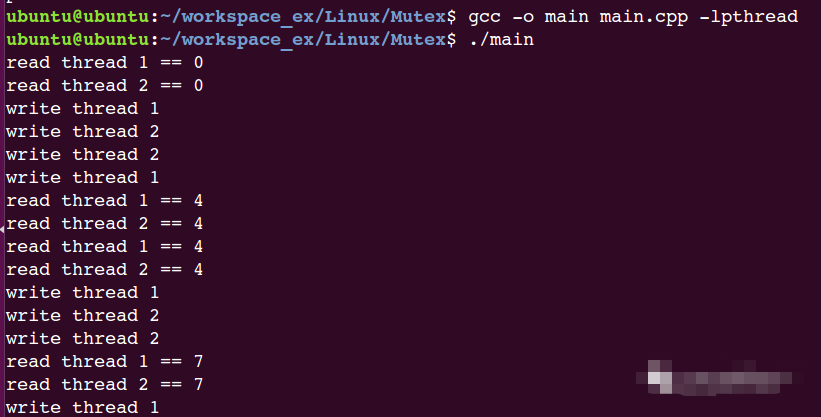








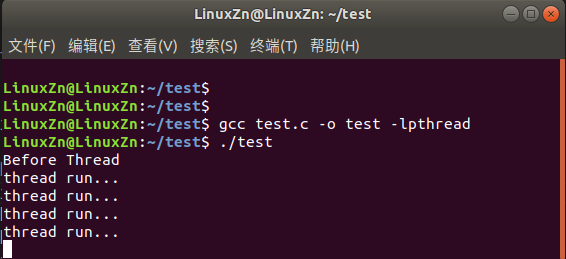
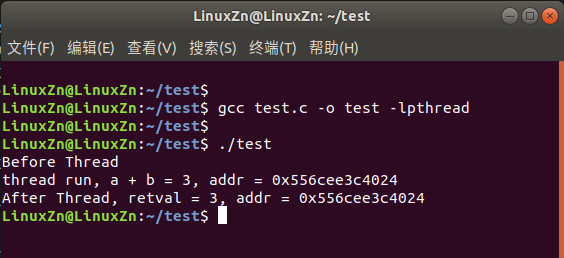
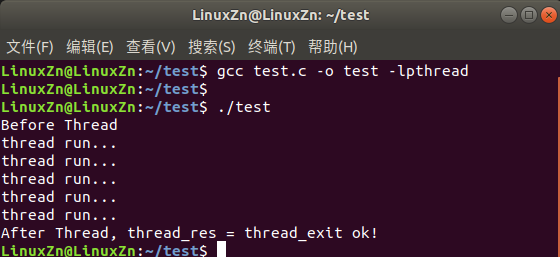
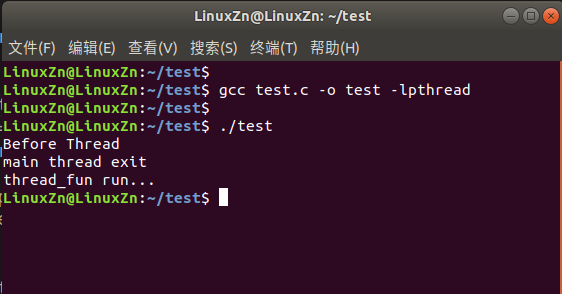
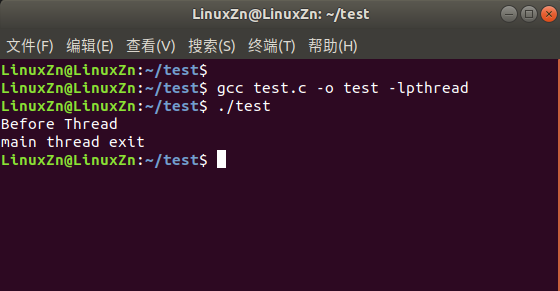
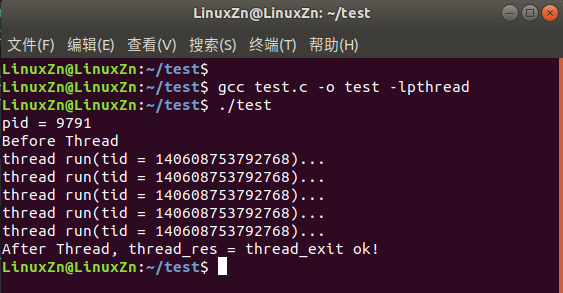
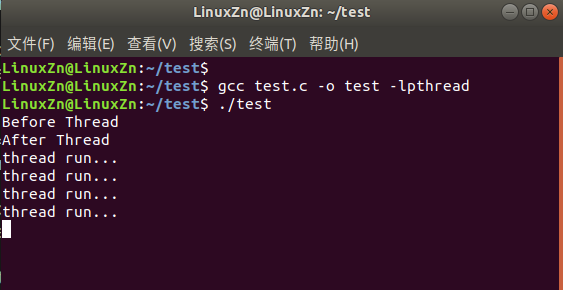
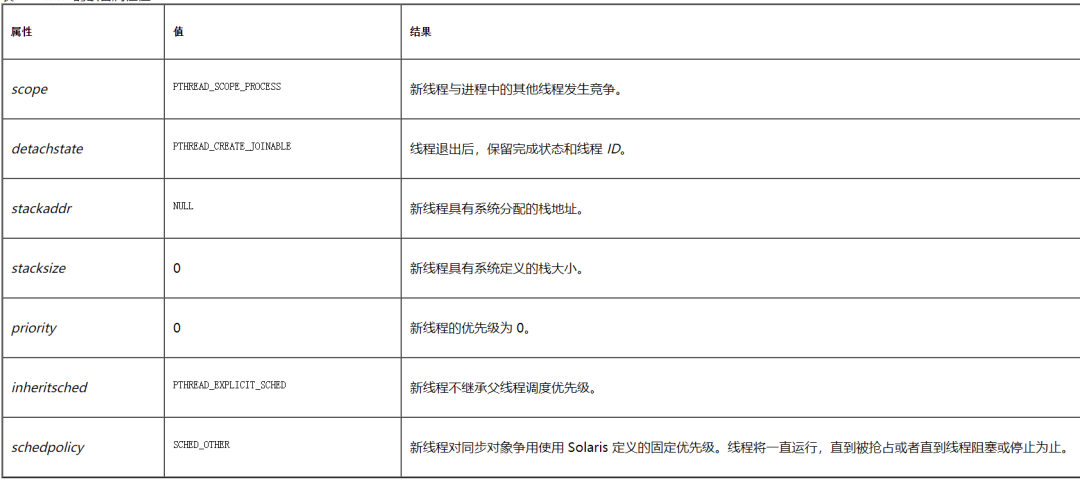

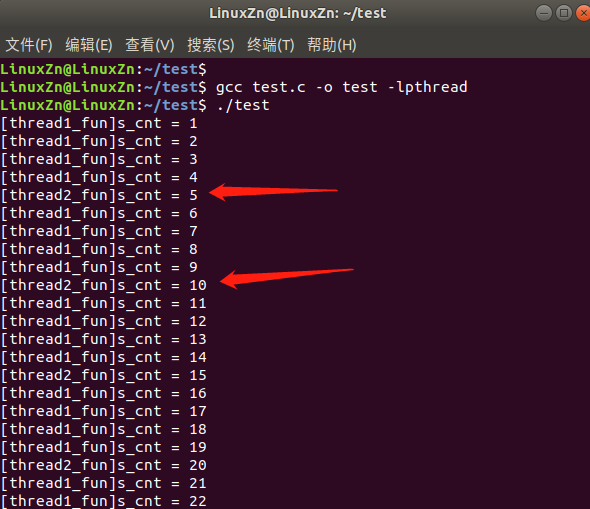












評論